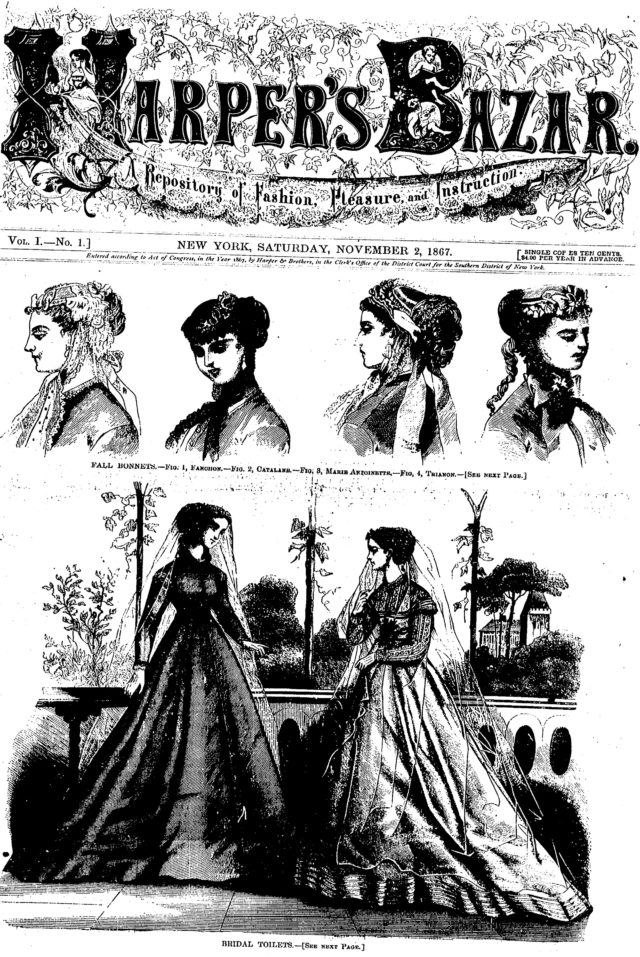Present at the Creation: Harper’s Bazar
It’s true! Wisconsin’s first woman lawyer helped launch America’s first fashion magazine. In 1867, Harper & Brothers, a highly respected publisher, sought to expand its audience with the revolutionary Harper’s Bazar,* a weekly journal that reported on style, explained how to pin a bun, commented on work, family, and social mores, and published poetry and fiction from prestigious writers like Charles Dickens, George Eliot, and Thomas Hardy. Lavinia Goodell was present at the creation.
Harper’s Bazar was the brainchild of Fletcher Harper, the youngest of the four Harper brothers who built the publishing empire. He modeled it after a similar German publication called Der Bazar, which illustrated stories with woodcuts of clothing that people were wearing in Paris, Vienna, and London. Fletcher arranged to obtain duplicates of the woodcuts in order to publish the same fashions in the United States.

Harper’s Bazar would guide wealthy women on how to live well in the modern world. It required an accomplished editor-in-chief. Fletcher chose Mary L. Booth, one of the first female journalists at the New York Times, author of History of the City of New York, translator of many important French works, including Gasparin’s Uprising of a Great People, praised by President Lincoln. For assistant editor, Fletcher chose Lavinia.
In a September 1867 letter to her parents, Lavinia described her new position, her impressions of the Harpers, and the staff’s long wait for the fashion plates from Germany:
. . . I am getting along very pleasantly in my new business. Am not as much hurried up, just now, as I expected to be. We are waiting for some plates from Berlin, and cannot get the first number out till they come. We have expected them every day for a week. The delay is good for me, as I have more time to get acquainted with my new duties, and arrange matters. We are reading and writing, and getting matters ahead. The first No. will be dated Oct. 1 but issued before that time. It will be called “Harper’s Bazar,” and will be devoted to fashion and light literature. This is not just as I wish it was, but I shall have little or nothing to do with the fashion department; which will be made up principally from foreign journals, which Mary will translate. There is no necessity for further secrecy about the matter. I have received my first installment of $12.00 and am to be paid weekly. The Harpers are very pleasant, genial men, and I think we shall get along nicely with them. Mr. James, the oldest, who used to be mayor comes in to see us every day, and chats very pleasantly. He is just as kind-hearted as he can be, and I already feel quite attached to him. You know my weakness for old gentlemen. He is 80, or more. Does not do business, only amuses himself by going around and seeing how things progress. I stay at the office from about 9 A.M. to 5 P.M. It is not obligatory to stay just so many hours, but that is about the time the other editors stay, and about the time necessary for the work we have to do. Of course I sometimes stay later, and sometimes not so late.
Like her family, Lavinia was dedicated to serious causes like equal rights, temperance and Christianity. Sensitive to their opinions of her new job at a fashion magazine, she explained:
If I paid instead of received twelve dollars per week, I should be doing well in gaining valuable information, and knowledge of human nature. Rear views are interesting and instructive. I should know now better how to write an article that would take.
And to her father, the preacher and abolitionist, Lavinia said of the magazine:
Perhaps the author of Democracy of Christianity, editor of the Genius of Temperance, etc. may not think it very profound, but it may serve to amuse a leisure hour, and possibly the fashionable world may be as well satisfied with it as if it was made of essays on the First Principles of Civil Government or the Nature of True Virtue. Should the aforesaid learned author and ex-editor, meet with an article from his own pen, he may modify his opinion of its intrinsic merit.
That almost happened. William Goodell had sent Lavinia an exposition of the word “bazar,” which she showed to Mary Booth and Fletcher Harper. They liked it so much that Fletcher asked Lavinia if he would allow it to be published under his name. Lavinia wrote: “I did not think you would object, so do not be shocked to find yourself a contributor to the first fashion magazine of America.”
William Goodell defined “bazar” as “taste in costume.” His letter to Lavinia about it may be read here. But Harper’s chose to describe “bazar” this way instead: “a vast repository for all the rare and costly things of earth—silks, velvets, cashmeres, spices, perfumes, and glittering gems; in a word, whatever can comfort the heart and delight the eye.”
CB
*Harper’s Bazaar was originally spelled Harper’s Bazar.
Sources Consulted: Letter from Lavinia Goodell to William & Clarissa Goodell, September 9, 1867; Maria Goodell Frost, Life of Lavinia Goodell (unpublished manuscript); Frances E. Willard and Mary A. Livermore, eds., A Woman of the Century, (Buffalo, N.Y.: Charles Wells Moulton, 1893); Stephen Mooallem, 150 Years of Harper’s Bazaar (last visited 12/3/19); Sari Rosenberg, November 2, 1867: The First Issue of Harper’s Bazaar Was Published (last visited 12/3/19); J. Henry Harper, The House of Harper: A Century of Publishing in Franklin Square (New York: Harper & Brothers Publishers, 1912).








It appears that the Harper brothers’ concept of what a “bazar” is won out over Wm Goodell’s. Maybe Harpers should be credited with broadening the concept.